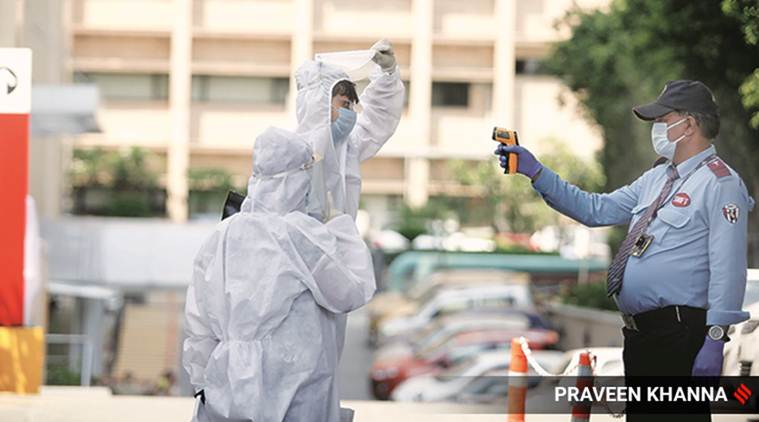 The total COVID-19 count is now 42,836, of which 1,389 have died and 11,761 have recovered. (File Photo/Representational)
The total COVID-19 count is now 42,836, of which 1,389 have died and 11,761 have recovered. (File Photo/Representational)
AS THE daily count of novel coronavirus (COVID-19) cases crossed 2,000 for the third day in a row and the deaths touched a new high at 83, the Ministry of Health and Family Welfare said on Monday that it is in the “nature of infectious diseases to increase with geometric progression”.
While 2,573 new cases were reported in the last 24 hours — the highest so far — there were 2,487 new cases on Sunday, and 2,411 on Saturday. The total COVID-19 count is now 42,836, of which 1,389 have died and 11,761 have recovered.
Responding to a question on why the daily count was increasing, Lav Agarwal, Joint Secretary, Health Ministry, said: “It is critical to understand that infectious diseases spread in geometric progression. Lockdown, physical distancing, containment — through a combination of all these, we have increased the doubling time from 3.4 days to 12 days. Lockdown and containment are yielding results, the challenge now is to better it as we continue to ease out, with continued support from the community.”
This is the first admission by the government that “breaking the chain of transmission” — which was said to be the goal of the lockdown — is unlikely to happen soon.
On April 24, the Press Information Bureau (PIB) had tweeted a graph that showed cases coming down to zero by May 16. “Decision of lockdown was timely, curve has begun to flatten. The nation has shown that lockdown has been effective, #SavingLives, containing #COVID19 infection and slowing down doubling rate. We need to build on these gains – Chairman, Empowered Group 1 #IndiaFightsCOVID19,” it tweeted.
The reference is to Dr V K Paul, member (health), NITI Aayog, who chairs the empowered group on medical emergency management plan.
Asked about the projection of a second wave in May-end or June, Agarwal said: “Talking about a peak is not the right way of looking at things. We need to see how to prevent the disease, save ourselves and work towards it. If we succeed, there may never be a peak.”
Top government sources, however, said the government is looking at a peak in the next couple of months. In a presentation shared with states in a meeting chaired by the Cabinet Secretary last week, the Centre had predicted that the total cases would touch 65,000 on May 15; 1,65,122 on May 31; 3,95,727 on June 15; 11,22,839 on June 30; 31,85,952 on July 15; 96,90,715 on July 31; and 2,74,96,513 on August 15.
Agarwal also said that instead of calling the extension of lockdown, with easing of restrictions, ‘Lockdown 3.0’, “we should call it easing out 2.0”.
“As the Prime Minister has said, jaan bhi, jahan bhi. We have to look at how to revive systems with community ownership and behaviour change so that the norm of social and physical distancing becomes a part of our life,” he said.
He said the outcome ratio (recoveries versus deaths) has improved since April 17. It is now 90:10, as compared to 80:20 earlier.
Niti Aayog CEO Amitabh Kant, who heads the empowered group on civil society organisations, NGOs and development partners, industry partners, and international organisations, gave details of the private sector’s participation.
“The private healthcare sector has been deeply committed in partnering the government to fight the crisis, offering capabilities even amid the compelling situation. Manufacturing companies are coming forward and utilising their plant, machinery and skilled manpower to mass manufacture equipment. For example, CII has launched a coalition of high-end manufacturing companies in automobile, machine tools and defence sectors to mass-manufacture ventilators,” he said.
“The Aspirational Districts Programme piloted by NITI Aayog has been a phenomenal success in uplifting the lives of millions in 112 most backward (aspirational) districts. As of now, there are about 610 cases in 112 aspirational districts, which is considered fairly low at less than 2 per cent of the national level of infections. Of these, six districts have reported their first case after April 21. The major hotspots are Baramulla (62), Nuh (57), Ranchi (55), YSR (Kadapa) (55), Kupwara (47) and Jaisalmer (34),” said Kant.